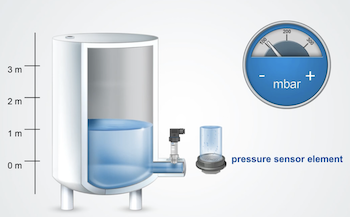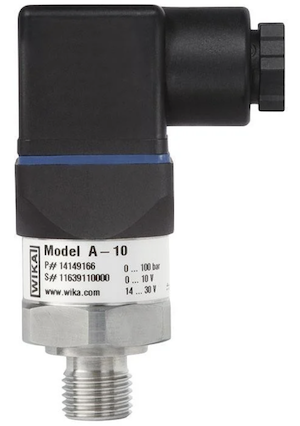Pressure sensors can be used to monitor the fluid level of enclosed vessels. Accurate output signals are key to keeping equipment and processes operating safely and efficiently, especially when working with small tanks and low pressure ranges.
The market offers many different ways to measure fluid levels. These include level indicators, glass level gauges, magnetostrictive or reed-chain level transmitters, ultrasound level sensors, laser level sensors, and differential pressure transmitters. But these instruments aren’t suitable for every application. Sometimes they’re too expensive, not precise enough, or too complex or impractical to install in a particular system.
When an application already has something – like an internal float or mixer – inside its small fluid tank, none of the above technologies are suitable. That’s when a compact pressure sensor is a good option for level measurement.
How a Pressure Sensor Measures Fluid Level

Hydrostatic level measurement using a pressure sensor
The pressure measured in a fluid is proportional to the height of the column of fluid above the pressure sensor. Therefore, the fluid level can be calculated using:
- The pressure measured in the tank
- The known density of the fluid
Installed at the tank’s lowest measuring point, the sensor element measures the pressure of the liquid column above it. A rule of thumb is that 1 meter of water column equals 100 mbar. This is the essence of hydrostatic level measurement. See this short video for an explanation of hydrostatic level measurement using a pressure sensor.
An important consideration when using pressure sensors for level measurement is their accuracy.
Importance of Accuracy When Monitoring Fluid Levels
Accuracy is defined as the difference between the measured value and the actual value. In an enclosed tank, inaccurate pressure readings can result in an inaccurate assessment of the fluid level. If the measured value is lower than actual, the tank could overflow. If it’s higher than actual, a pump could run dry, or a lubricating system could run out of fluid.
These situations can result in equipment damage, downtimes and delays, alterations to the process – and all the associated extra expense. The issues are particularly significant for small tanks that work with low pressure ranges. Even small errors can have serious consequences when monitoring fluid levels in equipment such as:
- Agricultural spraying truck tanks
- Lubrication and hydraulic system reservoir tanks
- Firetruck water and foam tanks
- Material handling systems that use low-pressure air to move products
There are currently several pressure sensors in the market that work at pressures of 5 psi or lower. To avoid costly problems, however, you must be certain that these devices can maintain accuracy specifications when used at those low pressure ranges. Many do not.
WIKA’s Answer to Pressure Sensor Accuracy

A-10 pressure transmitter
WIKA has improved its model A-10 pressure transmitter for general industrial applications by extending the working lower measuring range down to 0 … 20 inWC (50 mbar, ~0.7 psi). The upper range is 15,000 psi (1,035 bar). A high overpressure limit is recommended to avoid sensor failure.
A significant feature of the standard A-10 is that it not only offers extremely accurate measurements, but it also maintains standard non-linearity per BFSL (Best Fit Straight Line) of ≤ ±0.5% of span for all pressure ranges – even for the lowest ones. We can also produce the A-10 with even more stringent accuracy specifications, should your application require that. A free test certificate provides information on the measuring points recorded during manufacturing.
This high-performance pressure transmitter still has a compact design, a very competitive price, and WIKA’s worldwide support.
When it comes to accurately measuring pressure in machine tools, hydraulics and pneumatics, pumps and compressors, and process control and automation, the A-10 pressure transmitter offers unmatched configurations and optional features for industrial applications. Contact us for expert advice on which pressure or level sensor best fits your needs.
Product mentioned in this article:
• A-10 pressure transmitter

